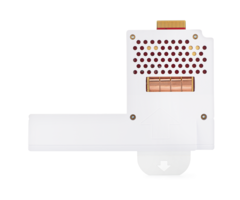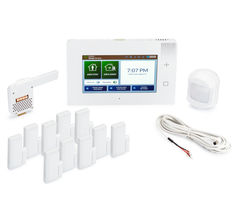How Do I Set Up a Cellular Communicator in a 2GIG GC3e?
You can set up a cellular communicator in a 2GIG GC3e by powering down the panel completely and then inserting the cell module into the designated sled slot. Once the module is installed, you can power the system back up and activate the communicator for alarm monitoring service.

A compatible cellular communicator is needed if you want to activate a 2GIG GC3e for monitoring service. This module allows the system to communicate with the Alarm.com servers. Alarm.com forwards any important events, such as system alarms, to a central monitoring station and/or the end user directly, depending on the user's monitoring plan. The user will also be able to control the system remotely through Alarm.com, provided that their plan includes this feature. The two most popular cellular communicators for the 2GIG GC3e are the 2GIG LTEA-A-GC3 AT&T LTE Communicator and the 2GIG LTEV1-A-GC3 Verizon LTE Communicator. Since the system already has a built-in WIFI card, adding a cellular communicator will make the system dual-path ready.
Please note that the GC3e has an option called Cell Radio Swap that allows you to change out a cellular communicator without powering down the system. To access the option, choose System Settings in the bottom-right corner of the main screen, enter the system's Installer Code (default 1561), and then scroll down to find the Cell Radio Swap option. You can then follow the on-screen instructions to replace a cellular communicator. Never install or remove a GC3e cellular communicator without first powering down the system or putting the system into its Cell Radio Swap mode.
Also note that the 2GIG LTEA-A-GC3 requires Firmware Version 3.2.3 or higher, while the 2GIG LTEV1-A-GC3 requires Firmware Version 3.1.3 or higher. Check out our GC3e Firmware Update Page if you need to learn more about GC3e System Firmware Updates.
For this FAQ, we will complete the process using the process of powering down. Complete the following steps to set up a cellular communicator for a 2GIG GC3e:
1. Access the panel inside. You will need to access the inside of the panel to remove the backup battery and power down the panel. You must first loosen the set screw at the bottom of the panel. Afterward, if you have not mounted the panel yet, then you can carefully pry off the back plate using a screwdriver. If the panel is already wall-mounted, then press the panel against the wall, and lift up to remove the main panel from the back plate. More information on opening up the GC3e can be found in this helpful FAQ.
2. Power down the panel. You must make sure the system is powered down completely before installing the communicator. First disconnect the backup battery from its plug-in port. Then cut AC power to the system. You can cut AC power by either unplugging the transformer from the outlet or unplugging the barrel connector from the system if you are using a Honeywell LT-Cable.
The picture below shows the system's backup battery. Note that it is already disconnected in the picture.

3. Remove the slot cover. Before you remove the cellular slot cover, you may need to remove the cover locking screw. If you don't, then the slot cover will not be able to be removed. To access the cover screw, first remove the front plate from the GC3e by sticking your fingernail or a flathead screwdriver into the crevice and then popping off the cover. The cover screw is found in the lower-left portion of the panel. There are two (2) screw slots. One slot is for locking, and the other is for unlocking. If the screw is in the locked slot, then remove it, and secure it in the unlocked slot so that it does not become lost. In the picture below, the cover locking screw is in the unlocked slot.

The cellular slot cover is found on the left side of the panel when you are facing the panel. Stick your fingernail or a flat tool in the crevice, and pull or pry the cover off. The picture below shows the cell cover removed.

4. Insert the communicator. Lay the panel face down with the open cell slot facing you. Have the communicator positioned with the arrow pointing upward. Slide the communicator into the slot. It should click into place. The picture below shows the communicator installed inside the panel. Note that the arrow on the communicator is pointing upward.

5. Note the IMEI Number. Before reapplying the cell cover, make sure to note the IMEI number on the sticker for the communicator. This sticker is visible after the communicator has been installed, with the cell cover still open. It may also be found on the product packaging. You must provide the IMEI number when activating the communicator.
6. Reapply the cell cover. Reapply the cell cover over the open slot. It should click into place. If you wish to lock the cover slot, move the locking screw from the unlocked to the locked position. Reinstall the front cover plate.
7. Power on the panel. You can now power the panel back on. Connect the battery first, then the transformer. Remember to run the power wire through the back plate so that you can properly close the panel.
8. Close the panel. You can now close the panel. If the back plate is on the wall, then position the panel over the back plate and securely click it into place. If the back plate is loose, then just position the back plate over the back of the panel, and click it into place. Position the top first, then press the bottom of the back plate into place.
9. Activate the communicator. Contact your alarm monitoring company to have them activate the communicator with Alarm.com. If you are being monitored by Alarm Grid, we will contact you at your scheduled activation time slot. Remember that you will be asked to provide the IMEI number as part of the activation. Follow these tips to make sure that your activation goes smoothly.
10. Run a cell test. The communicator won't be fully activated until a cell test is performed. The cell test can be pushed down to the panel, or it can be performed manually. To perform it manually, click the 2GIG logo in the upper-right corner, then choose the Radio Status option. Then follow the on-screen prompts to complete the cell test.

Did you find this answer useful?
We offer alarm monitoring as low as $10 / month
Click Here to Learn MoreRelated Products








Related Videos
Related Categories
- LTE Cellular Communicators
- LTE Cellular Communicators
- AT&T LTE Cellular Communicators
- Verizon LTE Cellular Communicators
- Answered

